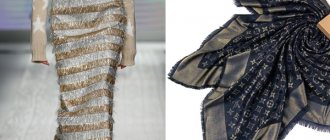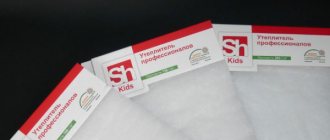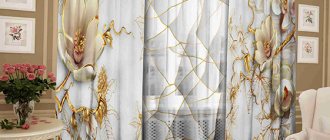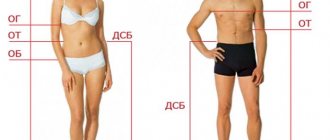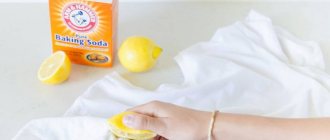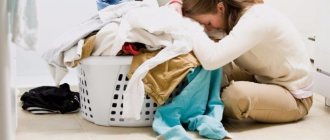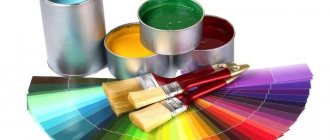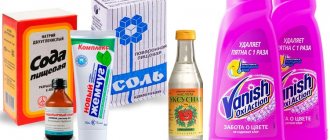History of appearance
From the very beginning of the world, everything shiny has been a sign of wealth and luxury. This countdown dates back to the founding of Ancient Egypt, in which the pharaohs wore clothes with woven gold and silver threads. In those days, only precious metals could shine, since artificial threads did not exist at all. Therefore, only wealthy people could afford such luxury. Now there are artificial substitutes that allow you to imitate precious metals without such material costs, so you can look luxurious with little investment. Lurex is one such material.
T. Eyu Dolan contributed to its creation. He had nothing to do with the production of fabrics and it was not he who created Lurex. He was the owner of a cigarette packaging business. Dolan came up with the idea of placing aluminum fibers in plastic packaging, which made the aluminum much stronger.
This was the beginning of the journey of Lurex. When fabric manufacturers saw Dolan's patent, they were interested. Threads can be found in many fabrics and knitting yarns.
General definition
Today there are a huge number of different types of threads (photo presented below). They are called in professional language twisted products. They can be indefinitely long. Flexible textiles, which by definition are threads, are spun from individual fibers.
Sewing, embroidery and knitting products can be made from natural or synthetic materials. Without threads it would be impossible to sew clothes or create fabrics. They are used both in industrial production and in handicrafts. The threads can either be the final product or undergo further processing.
Depending on the area of application, several types of threads are distinguished. If you need to connect individual parts of shoes, clothing and other similar products, twisted sewing products are used. If you need to finish fabrics, you need looped cords. A separate type of thread is also produced for knitting. Hand and machine embroidery is created from floss.
Considering the types of threads and their purpose, it should be noted that this indicator largely depends on the characteristics of their production. This is influenced by the type of fiber, weight, number of folds and type of weave. Thinness also affects the properties of threads. This is an indicator of the cross-section of the fibers of flax, cotton and other types of materials.
The threads vary in cross-sectional size. The thicker the thread and the more densely the fibers are folded in it, the stronger the cord will be. This indicator is also greatly influenced by the type of material from which the yarn is made.
During processing, the threads are dyed in a variety of colors. Their range is extremely large. Moreover, threads of various shades are produced for embroidery. This is necessary to create a quality product. Technical threads, which are used, for example, for sewing bags, can be the same color. In all cases, depending on the application, color fastness is important. The higher it is, the better and more expensive the thread.
What and how is thread made from?
The raw material for the production of Lurex is foil from various metals. It can be aluminum, brass, copper or nickel - they all have different shades, hence the variety of colors. And also, in order to obtain shades unnatural for metals (for example, purple or black lurex can be found on sale), the foil is additionally painted with various pigments.
After this, an emulsion is applied to the sheet, which dries and forms a film that provides protection to the foil. Thanks to it, lurex has greater tensile strength, while foil is easy to damage.
A new technology is the production of lurex from film, and to create color it is painted with glue. This material is stronger, and the color palette has become much more diverse.
Description and characteristics
Lurex is a shiny thread that is added to the structure of the fabric to create the effect of shine and luxury. It runs like an additional fiber intertwined with the threads of the material. This achieves an unusual look for the fabric, and if the Lurex is colored, the result is a melange shade.
Fabric with lurex added looks beautiful because its color shimmers in the light. And if you take, for example, black knitwear and add light lurex to it, you can create an imitation of the starry sky - this is a frequently encountered theme for imitation in clothing.
In addition to external qualities, it is worth noting that the fabric acquires greater strength, since Lurex is more difficult to tear than regular thread. Threads made not from foil, but from film, are especially distinguished by their strength.
The downside is a slight tartness. This happens because the lurex thread is not round, but flat, and when woven into the structure of the material, it can bend, forming sharp corners. But this is almost unnoticeable, and if you wish, you can wear a thin T-shirt under such a jacket.
Types of fabrics with lurex
Lurex is added to any fabric, both natural and artificial. Its content can range from 3 to 30 percent, the more, the more shiny the material will be.
- Polyester is one of the cheapest materials from which any wardrobe item is made. For example, you can purchase a polyester scarf with lurex thread.
- Cotton – Shine is also added to natural fabrics like cotton or linen. You can buy a cotton blouse with a small addition of lurex - this way it will not only be pleasant to the body, but also sparkle with beauty.
- Viscose is another artificial material, but of natural origin. Similar to polyester, many different clothes are made from it, to which lurex can be added.
- Knitwear is perhaps the most popular category of all. Lurex is woven into the structure so that the item continues to stretch, so even dresses with adjacent silhouettes can be combined with it.
Tatting threads
Tatting threads are an excellent material for creating beautiful openwork products using the tatting technique. Women's clothing decorated with lace and multi-colored stones looks elegant. This technique has come down to us since historical times, when the clothes of noble nobles were decorated with unusual lace elements. Any products created by such an unusual weave from a variety of threads look exceptional. It is important to know how to choose the right tatting threads.
Types of threads
Yarn for knitting using the tatting technique is divided into several types:
- cotton;
- silk;
- polyester.
All types of yarn are twisted and untwisted, of different thicknesses.
The cotton base is natural and simple. It is preferable to make clothes from it, as it is pleasant to the human body. It is very difficult to learn to weave from such fiber, since the knots created are difficult to unravel.
Polyester threads look irresistible; they are shiny, slippery, strong - the most suitable for knitting. They form beautiful and even little knots, which is very preferable in this technique. They are suitable for weaving jewelry, collars, napkins and combine well with beads. The downside is the curling. It will be difficult for novice craftswomen to work at first, but with practice, the problems will disappear into oblivion and the workers will see their masterpiece created with their own hands. The ends of such a thread should be hidden under four knots to prevent the tail from slipping out.
Threads for creating lace elements using the tatting technique also differ in manufacturer and material properties. In order to understand more precisely, let’s consider the information verified by experienced needlewomen.
Description of threads
Having thoroughly understood this issue, you can easily confirm reliable facts verified by personal experience.
First
YarnArt Canarias thread is produced in Turkey in packages of twenty-five and fifty grams.
Excellent quality of flowing, thin, even, high-quality twisted fiber. Knitting from it is easy and quick - the knots come out all the same and without flaws. The manufacturer offers a wide range of colors necessary for creating art.
Second
Altin Basak number fifty is made in miniature balls. The thread is high quality, finely and smoothly twisted.
The manufacturer provides the consumer with many shades of its product.
It is a pleasure to weave knots with the material described above - it glides, is moderately hard, and smooth.
Third
Altin Basak Klasik - at first glance, an excellent mercerized fiber, shiny, strong, packaged in large hundred-gram skeins with a huge meter per kilometer. It would seem that everything is excellent, but it is thin in places, thick in others, which is unacceptable - it is difficult to weave with such a thread, especially for new craftsmen.
Fourth
Elif Dantel - made in Turkey, average quality, shiny, slippery, all kinds of colors, very thin, laid out in even rows. The workflow with Elif Dantel produces perfect knots.
Fifth
Limol, made in Portugal, is used by our craftsmen for clothing and lace products, fits well, the loops are formed perfectly.
Fifty grams contain three hundred and thirty-four meters, which means that the fiber is compacted, consists of mercerized cotton, with good twisting and a variety of shades, making it possible to translate vivid fantasies into work and create interesting, woven models.
Sixth
Spanish thread Finka Perle, produced under four license plates: fifth, eighth, twelfth and sixteenth in small balls.
The thread, which attracts attention, is strong, but has thickenings throughout the entire length, which negatively affect the creative procedure.
Seventh
French DMC Perle #12 is of high quality, available in three numbers: 5, 8,12, depending on the thickness - a large number value corresponds to the thinnest thread.
Number five is very similar to our “Iris”, it is soft and pleasant in itself, the product is also noted for its softness.
Eighth
Venus #70 is a nice, high-quality yarn, in a variety of colorful colors, but expensive.
Ninth
Yarn from a Japanese manufacturer, Olympus No40, has proven itself to be positive.
It is correctly twisted, without changes or defects, smooth, strong, and looks beautiful. The diverse range of colors captivates with its richness and colorfulness.
Tenth
Yarn specially created for weaving using the tatting technique is Lizbeth, which is noted for its high-quality material, tight twist and slight rigidity.
The range of thread colors from this manufacturer is unique and is constantly being added. There are both monochrome and melange shades. Yarn of various thicknesses is produced: the higher the digital value, the thinner the thread. It is a pleasure to knit with it - there are no changes in volume along the entire length. Perfect wicker items are created from it - from clothing to jewelry.
Eleventh
Microfiber called YarnArt Tulip is a shiny synthetic thread. Threads of this brand in various shades are presented with different properties: some are soft, easy to knit, others are hard, curling.
In general, you can learn to weave with this fiber. The elements are moderately rigid.
Twelfth
A combination of two threads - YarnArt Tulip and Madeira No40, is used for weaving using the tatting technique. Microfiber and lurex are not the best combination, but they look good.
Thirteenth
Thick nylon yarn – Mosnitki 350 l. They behave very well in weaving rings. The rings come out the same size, lie flat and neat.
Fourteenth
Fiber made from cotton and entwined with lurex - YarnArt Violet Lurex.
Not a bad yarn, but it will be difficult for beginners to work with. It is better to learn from sliding and hard threads.
Having become familiar with the yarn that is used to weave original lace products, you can proceed to your plan and create unique and non-repetitive luxury items using only the best tatting threads.
We recommend watching a video master class on tatting threads for knitting:
Types of yarn with lurex
Another popular category of products with shiny thread is yarn. It comes in several varieties:
- Synthetics – 100% acrylic.
- Natural - wool (for example, angora), cotton.
- Blended - for example, 50% wool and acrylic each (there may be other ratios, depending on the type of yarn).
Lurex can be added to any of these types, but is most often found in synthetic and blended types.
Care instructions
The material does not like experiments with temperature and detergents. Despite the fact that this is a synthetic material, which itself has sufficient strength and durability, it requires careful handling during washing. And also, in addition to the rules for caring for lurex, you should also pay attention to the fabric into which it is woven. For example, wool or cotton will not tolerate high water temperatures and hard powder.
It is advisable to wash the products by hand, but you can use the delicate washing cycle in the machine. It is better to set the number of degrees to no more than 30, and when using the machine, the item must be additionally protected by placing it in a special washing bag. It is worth considering this for wool and knitwear - they can become deformed. You should also avoid squeezing, but it is permissible to lightly squeeze the product from the water with your hands.
You can dry the item vertically by hanging it on a hanger, but it is worth remembering that if it is wool, it can stretch, then it is advisable to lay the jacket horizontally on a towel. Dry away from heaters and avoid direct sunlight.
Ironing is not recommended as the threads may melt under the soleplate of the iron. This can be done if there is little material in the composition (3%-5%), but only at a low temperature (synthetic mode) and through matter.
After washing and drying, you can store the item on hangers or put it folded on a shelf - this will not damage the shiny fibers.
Varieties of shiny fabrics
Shiny fabric was especially desirable in the late 80s and early 90s of the last century. This is the era of bright clothes, colorful makeup and, of course, the multifaceted disco style. Then the passions subsided a little, and only theater actors or at concerts of famous artists wore sequin outfits. But fashion tends to come back and modernize, so today bright dresses of different shades, blouses, jackets, accessories, etc. are back in trend. You can meet a lady in such an outfit not only at a party, but also in everyday life.
Sparkly pink dress
Shine is imparted to fabrics in different ways, the main ones being:
- the type of thread weaving, thanks to which the material acquires a smooth surface;
- composition of fibers that gives the canvases shimmer;
- the use of sequins and special spraying;
- use of metal threads.
Iridescent fabric is distinguished by its features and characteristics. Therefore, there are basically several types of matter being described.
Satin and satin
Atlas denotes the properties of the material, because it is not without reason that this word means “smooth” in translation from Arabic. Various outfits are sewn from linen: wedding and evening dresses, blouses, bed linen, sleep sets, tablecloths, curtains, etc.
This silky surface of the material is achieved through a special satin weaving of threads. A distinctive feature is the prevalence of warp threads on the surface covering the weft. Due to this structure, mixed fibers are used in the production process. The front side is completely silk, and the back side is synthetic or cotton.
Satin blue dress
Silk fibers are not always used for the base. The eraser fabric, made according to the principle of satin weaving, has a 100% cotton composition, but it is characterized by an interesting shimmer. It is used for sewing clothes, as well as various textile products.
Attention! In 2021, satin slip dresses are especially popular.
There is another equally popular weaving of threads, due to which the materials receive an amazing shine - satin. It is radically different from satin, since the front surface is made up of weft threads, and the main ones are overlapped by them.
Emerald satin top
Satin is a shiny cotton fabric that is one of the most sophisticated and expensive materials. Bed linen made from this fabric is more like a real work of art. The drawings and patterns are made so delicately that you can admire the ornate lines ad infinitum. Mako-satin is considered the strongest and most durable. For its production, special varieties of cotton grown in India and Egypt are used.
You might be interested in this Features of satori fabric: what the material is made of
Organza and taffeta
Basically, artificial fibers themselves have natural iridescence, and therefore do not require additional processing during the production process, which cannot be said about natural materials. Often, such fabrics are used in the manufacture of textile accessories, but not everyday clothing, unless we are talking about stage and evening wear.
Fuchsia organza
Organza curtains can add oriental notes to the interior. This sequin fabric is made from polyester. To give the material even more shimmer and shine, a certain amount of viscose and natural silk is added to it.
Therefore, manufacturers produce several types of organza:
- header - creates the effect of various folds and creases, sometimes with spraying;
- crash – has the texture of cracked glass.
Admirers of iridescent fabric value most of all chanzhan organza, which is also popularly called “chameleon”. Thanks to the special weaving of multi-colored threads, the surface of the material acquires different colors at a certain angle.
Taffeta is a type of polyester fabric, the peculiarity of which is fibers tightly connected to each other through a plain weave. This production method adds more shine to the canvas.
Taffeta shirt
The scope of taffeta is quite wide. It is often used for sewing evening and wedding dresses, exquisite shawls, luxurious stoles, and carnival costumes. The material is also used to sew curtains, tablecloths, napkins, decorative elements, and sofa cushions. And the upholstery on chairs and sofas made of canvas leaves no one indifferent.
Organza and taffeta are irreplaceable fabrics that can radically transform the interior, making it more colorful and cozy.
Coated fabrics
A thin layer of metallized coating is applied to the canvas using special equipment under vacuum. Small particles of the product settle on the surface, thus reliably connecting with the threads. The base is 100% polyester.
There are fabrics with a single-color coating, original patterns, and designs. The intensity of the shine also varies: weaker, richer, softer. However, each canvas attracts and fascinates in its own way.
Metallized fabric
The materials are used not only for sewing luxurious outfits. They are in high demand in the manufacture of spectacular roller blinds and drapes. The advantage is that spraying not only performs a decorative function, but also reflects the bright rays of the sun, thereby lowering the temperature in the room.
Interesting! Designers love metallic plating and use it in all outfits, especially in futuristic style.
If you want to diversify your interior, but don’t know which metallic curtains to choose, pay attention to products with pearl coating. They will match with any decor. The fabric does not accumulate static electricity, dust and dirt. These advantages are achieved through the use of special solutions and impregnations.
You might be interested in Description of polysatin: what it consists of, use for bed linen
Fabrics with lurex
Translated from English, the word “Lurex” means seduction, temptation. The fabric is used to make underwear, stockings, tights, evening dresses, skirts, and blouses. The material gives the products a special appeal and seductiveness.
Tinsel
By the way, Lurex is a very thin metallized thread, which is obtained by “mining” from nickel, aluminum or copper foil. Production is concentrated in Japan and China, Italy, and the USA. You can combine threads with any fibers: wool, cotton, synthetic, silk. Knitted clothing looks impressive when the yarn is combined with metallized threads. There are expensive fabrics that are diluted with lurex threads.
- Brocade is the most luxurious and rich material. Previously, gold and silver threads were added to it. However, now, in order to save money, they use thin polyester foil, which is given different shades. Brocade is used for sewing theatrical and concert outfits, large curtains and drapery. Brides who prefer chic and gloss often order wedding dresses made from this material.
- Lame. This shining canvas means “metal plate” in French. In terms of its characteristics, lamé is similar to brocade, but the fabric is much thinner and lighter. The front side is shimmering with matte patterns, and the back side, accordingly, is devoid of such reflections. Such an unusual texture is a real springboard for the creativity of fashion designers. Using this material, famous couturiers create masterpieces, thereby making a contribution to the industry. Lame is used not only for making clothes, but also for textiles. However, there is a significant drawback: the fragile canvas can be damaged even under the slightest load.
Sweaters with lurex
Jacquard and tapestry fabrics are often decorated with lurex. Bedspreads and curtains, upholstery and curtains look exclusive and add sophistication and a spirit of aristocracy to the interior.
Fabrics with sequins
Despite the fact that products with sequins look original and unusual, the materials are quite finicky not only when sewing, but also when wearing. Cotton fabric is mainly used as lining. It should be weightless so as not to overload the outfit. Chiffon or synthetic mesh are ideal for these purposes.
Richness of sequin shades
To make sequins, plasticex or metal is used. They are also attached in different ways: sewn or glued to the canvas. Outfits with sequins are not too expensive, they require careful handling and careful wear.
Products sewn to fabric are also quite capricious. When sewing expensive clothes, sequins are attached using thick thread, so you don’t have to worry about the decoration getting lost at the most inopportune moment. With budget outfits the situation is different and with the slightest wrong move you can lose a good part of the sparkles.
Sequins and street style
When purchasing outfits, make sure that they come with a cover, otherwise the sequins will irritate and scratch the skin. It is recommended to wash the products by hand without twisting them. No ironing required.
You might be interested in what suprem is: fabric features
